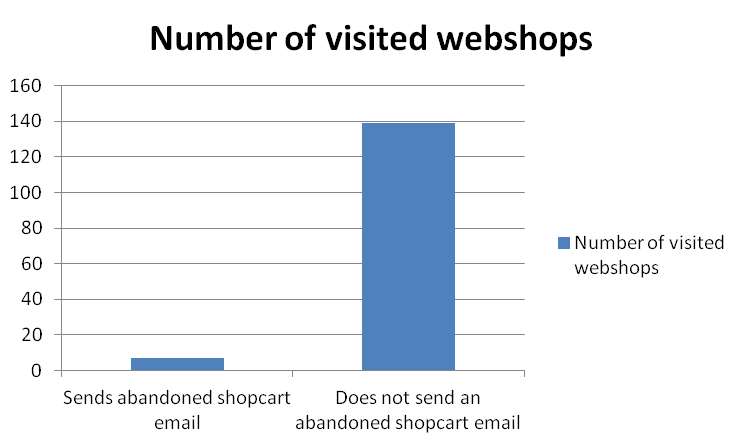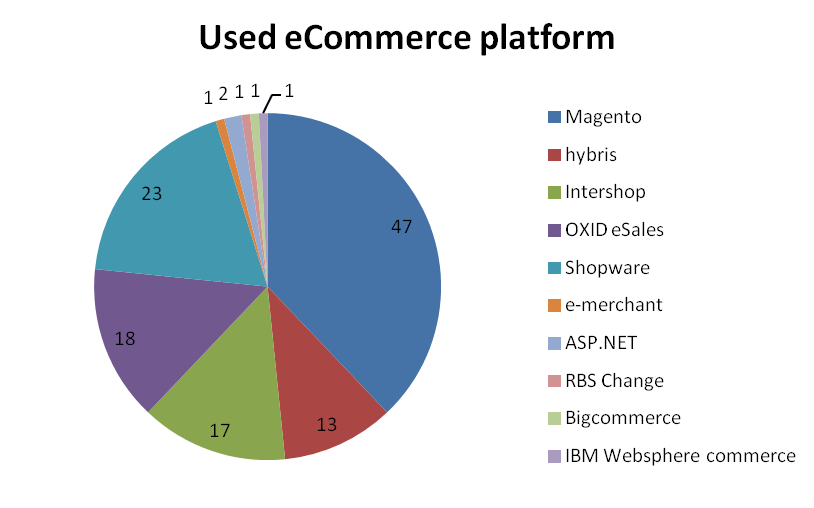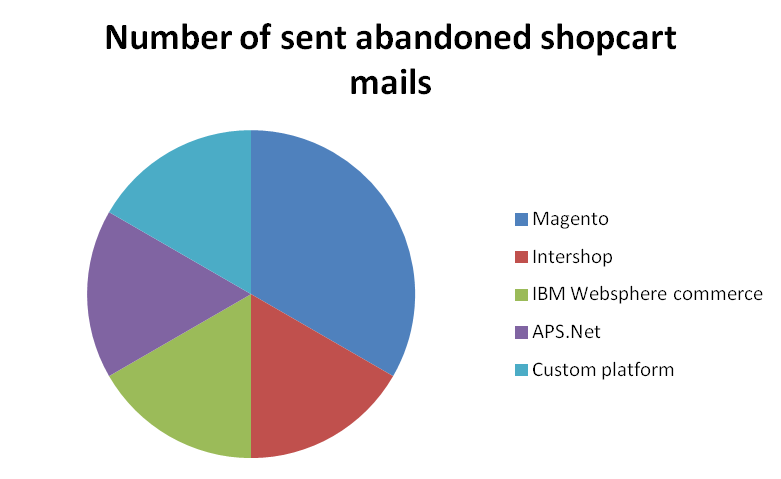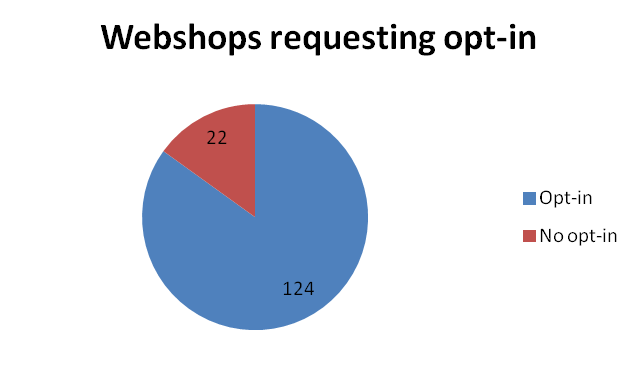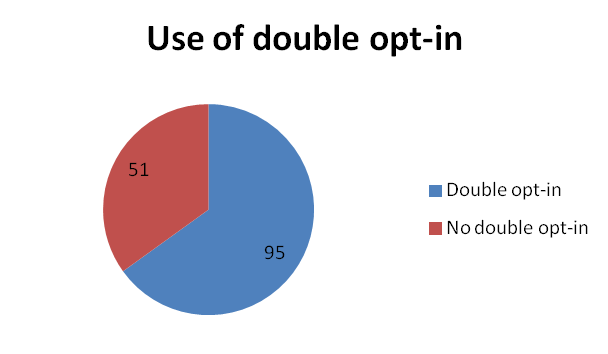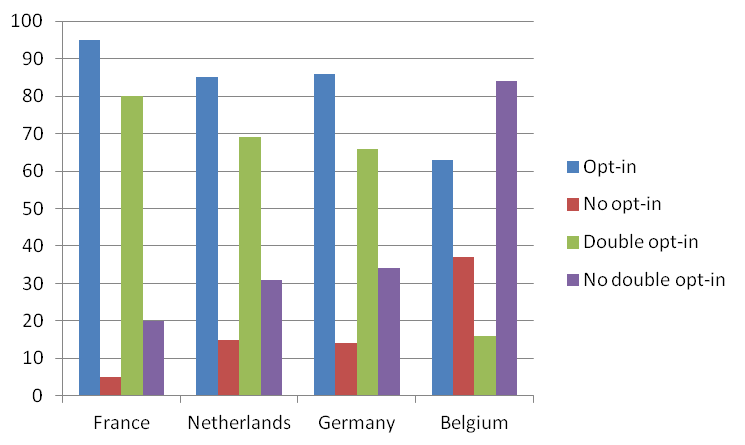The use of abandoned shopcart emails in Europe

The European eCommerce market is thriving. The European market overtook the world’s largest market, the US, in 2010. Two years later, in 2012 the European B2C eCommerce market grew by 19% (source: Europe B2C Ecommerce Report 2013). In other words, it’s a booming market in which many hope to achieve success.
And there are many ways for webshops to achieve a higher conversion. We wondered how European webshops use email marketing in the process of conversion optimization and were especially curious in what way the e-marketing strategy of abandoned shopcart emails was applied.
Based on our own experience we know that there are still too much webshop owners that don’t fully exploit the data they gather from their webshop. Data obtained from abandoned shopcarts for example.
Assisted by partners from Belgium, the Netherlands, France and Germany we decided to visit several webshops to see if they used this event driven email campaign and what the differences were per country and per eCommerce platform used.
Who sends an abandoned shopcart mail?
The assignment for ourselves and our partners was clear. Visit several webshops, subscribe to their newsletter, create an account, fill your shopcart with different products and see if you’ve received a follow-up campaign after several weeks. And what did we see?
Only 4,7% (7 out of 146) of the webshops we visited, sent out an abandoned shopcart email after we left our shopcarts unattended.
Why do so little etailers use such an effective email marketing strategy? There could be several reasons. We decided to look at the possible reasons and noticeable differences per country and per eCommerce platform.
The difference per eCommerce platform
When dealing with webshops there is a wide variety of possible solutions an etailer can use. The most well-known platforms are Magento and hybris. But apart from these, there are numerous others such as Shopware, OXID eSales, ASP.NET, Intershop and IBM Websphere commerce. These are the platforms used by the webshops we visited:
The use of these eCommerce platforms varies per country. Shopware and OXID eSales are popular platforms in Germany. Magento is used a lot in Germany and the Netherlands while Intershop and Hybris are well known platforms in Belgium. But we’ll get back on the differences per country later.
All platforms are very powerful tools, but in all cases they lack various marketing options. Like the possibility to set up elaborate email campaigns by using your own HTML template. This is also something you can see in the results per platform. In 2 out of 146 cases, an abandoned shopcart mail is sent using Magento, 1 via Intershop, 1 via IBM Websphere eCommerce, 1 via ASP.NET and 1 through a custom made platform (see figure 3).
“The different eCommerce platforms are primarily capable of sending transactional emails which are quite basic, such as an order confirmation or order tracking email. When you want to set up elaborate email campaigns for your webshop such as an abandoned shopcart email, you will have to use an email marketing platform,” says to Lonneke Spinhof, Senior UX Consultant at HUMIX (Belgium).
That is why it is wise to see whether there are integrations available that enable you to link you eCommerce platform to your marketing software system. By saving all of your data in that system, you’ll be capable of setting up elaborate and highly personalised email campaigns for your clients. Such as abandoned shopcart emails or cross-selling and up-selling campaigns.
Difference per country
Permission: opt-in & double opt-in
As mentioned in the beginning of the article we checked the use of email marketing for several webshops in different countries. Next to the use of an e-marketing strategy such as an abandoned shopcart strategy, we also looked at how many of these webshops actually asked for permission to send emails. This led to some remarkable findings:
Even though requesting permission to send emails is obligated in all examined countries, there are still 22 out of 146 webshops we visited that do not request an opt-in. Next to the normal opt-in procedure, we also investigated how many of these webshops actually applied a double opt-in:
Whether or not a webshop uses opt-in and double opt-in is something which depends on the legislation in each country. For example, in Germany webshops (and other website owners) are obligated to use double opt-in for each newsletter subscription. In the following graph you can find an overview (percentage) of the use of opt-in and double opt-in in the four countries we visited webshops.
What stands out in this graph is the low usage of opt-in and double opt-in in Belgium. And the higher usage of double opt-in in the Netherlands, Germany and France. It’s of the utmost importance to have permission to send emails in these three countries.
However the legislation in Germany is even stricter. If you want to send out campaigns based on order history, you will have to ask for official permission from the client in order to send these types of campaigns. Something which doesn’t contribute to the use of these campaigns at all, confirms Dennis Arquillano of Atlantis Media GmbH (Germany).
“We see that a lot of our clients are willing to start using abandoned shopcart campaigns. But they are held back by German legislation and the vague and strict rules that have been formulated for these types of campaigns.”
Use of abandoned shopcart campaigns per country
We’ve noticed that there are only a few webshops who use abandoned shopcart emails. In Germany and Belgium this type of email marketing isn’t even applied at all in the webshops we visited.
Only 6 webshops in total in France and the Netherlands apply this strategy (3 in France, 3 in the Netherlands). So why is it that so little webshops use this type of email campaign? According to Carolien Hoffman of the Dutch internet agency Cream, one of the reasons is an unequal distribution of the marketing budget.
“The eCommerce trajectory can be divided roughly into three phases for a webshop owner: generating traffic to the webshop/acquiring new customers, making sure these visitors generate an income (conversion optimization) and stimulating repeat purchases (for example through email marketing). We can see that most of our clients focus on generating traffic to their webshop and acquiring new customers, leaving little or no budget for conversion optimization. Campaigns such as an abandoned shopcart email are generally used in phase 2 or 3. Something most webshop owners don’t focus on. Once we show them how much revenue they miss out on by not using abandoned shopcart mails, most webshop owners will reconsider the use of these campaigns.”
Differences found per country
It can be said that webshops from all countries pay close attention to using opt-in and double opt-in correctly. However, in countries such as Belgium and Germany some webshops still tend to ignore these rules.
Furthermore, you would expect the Dutch and German webshops to apply event driven marketing campaigns. However, as it turns out, French webshops also use this type of email marketing. “The strategy isn’t that popular amongst French webshops yet but its popularity is rising. We can notice this amongst our clients and within the French eCommerce market as well. The fourth and fourteenth largest webshops in France already apply abandoned shopcart campaigns. Using this form of event driven marketing has become a ‘hot topic’ amongst French webshop owners this past year,” says Sebastien Daunit, project manager at aYaline (France).
That the French eCommerce market is growing rapidly is also pointed out by results published by Ecommerce Europe. The number of eshoppers in France has grown with an amazing 500% since 2000 making France the world’s sixth largest eCommerce market (source: Europe B2C Ecommerce Report 2013).
That same report also tells us that the Dutch and English market have matured compared to the German and French market. Which means they didn’t grow in revenue as much as the German and French market in 2012. While the eCommerce market in the Netherlands is expected to grow by 10 to 15%, the expected growth for Germany and France ranges from 20 to 25%.
Belgium seems to be lingering in the back a bit. This is also pointed out by Humix: “Belgium is still a bit behind when it comes to eCommerce and email marketing. Most companies are just taking their first steps when it comes to email marketing. Which means, working with structured and segmented email lists and using the basic functions of email marketing software and eCommerce platforms.”
Conclusion
Although we just visited a small percentage of the total eCommerce market (there are around 550.000 webshops in Europe) and looked at how they follow up on abandoned shopcarts, we still found that only a mere 7 out of 146 applied the strategy. Which does tell you something about the ‘popularity’ of this emarketing strategy.
The main reason all of our partners pointed out is the strong focus webshops put on generating traffic and getting new customers to their webshop. Leaving no budget or time for providing a better service to their existing, loyal customers.
Without knowing it themselves, they are missing out on conversion. According to our partners they saw an increase in conversion and revenue once webshops started using abandoned shopcart campaigns. The investment put in to it is worth every single penny!
An insightful study of the use of
abandoned shopcart emails in Europe
by Copernica Marketing Solutions.
LAW Creative is a registered partner of Copernica Marketing Software. Copernica is an international developer of powerful marketing software with over 3,500 users. If you would like to discuss how we can forge strategy, data, technology and creativity into a potent e-marketing plan on behalf of your business please contact brett.sammels@lawcreative.co.uk
Related articles


